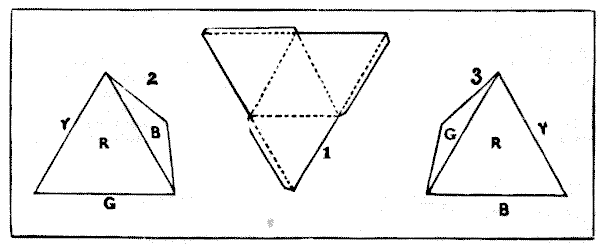This puzzle concerns the painting of the four sides of a tetrahedron or triangular pyramid. If you cut out a piece of cardboard of the triangular shape shown in Fig. 1, and then cut half through along the dotted lines, it will fold up and form a perfect triangular pyramid. And I would first remind my readers that the primary colors of the solar spectrum are seven—violet, indigo, blue, green, yellow, orange, and red. When I was a child I was taught to remember these by the ungainly word formed by the initials of the colors, "Vibgyor."

In how many different ways may the triangular pyramid be colored, using in every case one, two, three, or four colors of the solar spectrum? Of course, a side can only receive a single color, and no side can be left uncolored. But there is one point that I must make quite clear. The four sides are not to be regarded as individually distinct. That is to say, if you paint your pyramid as shown in Fig. 2 (where the bottom side is green and the other side that is out of view is yellow), and then paint another in the order shown in Fig. 3, these are really both the same and count as one way. For if you tilt over No. 2 to the right it will so fall as to represent No. 3. The avoidance of repetitions of this kind is the real puzzle of the thing. If a colored pyramid cannot be placed so that it exactly resembles in its colors and their relative order another pyramid, then they are different. Remember that one way would be to color all the four sides red, another to color two sides green, and the remaining sides yellow and blue; and so on.
Solutions: 1
This eBook is for the use of anyone anywhere in the United States and most other parts of the world at no cost and with almost no restrictions whatsoever. You may copy it, give it away or re-use it under the terms of the Project Gutenberg License included with this edition or online at http://www.gutenberg.org. If you are not located in the United States, you'll have to check the laws of the country where you are located before using this ebook.